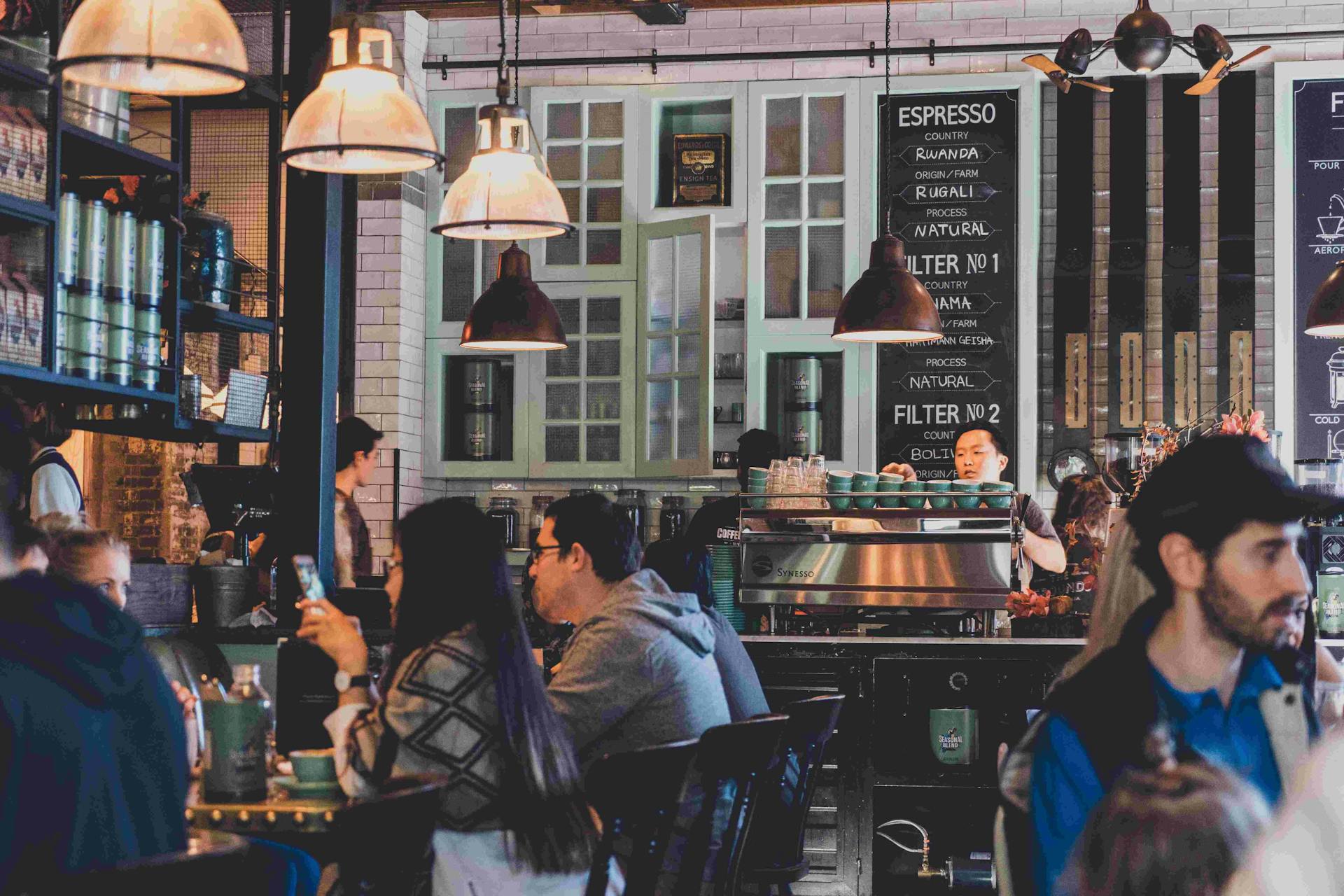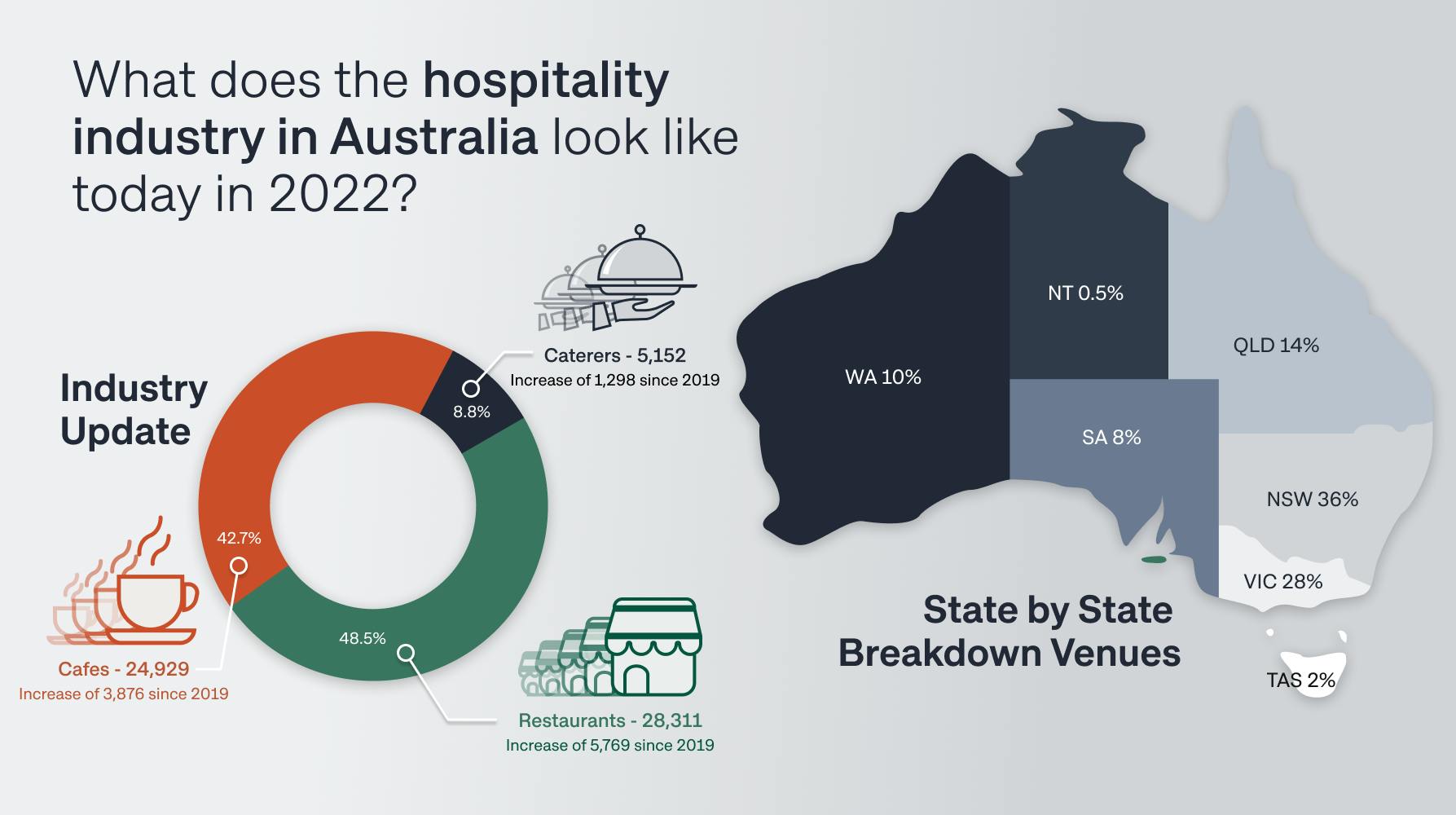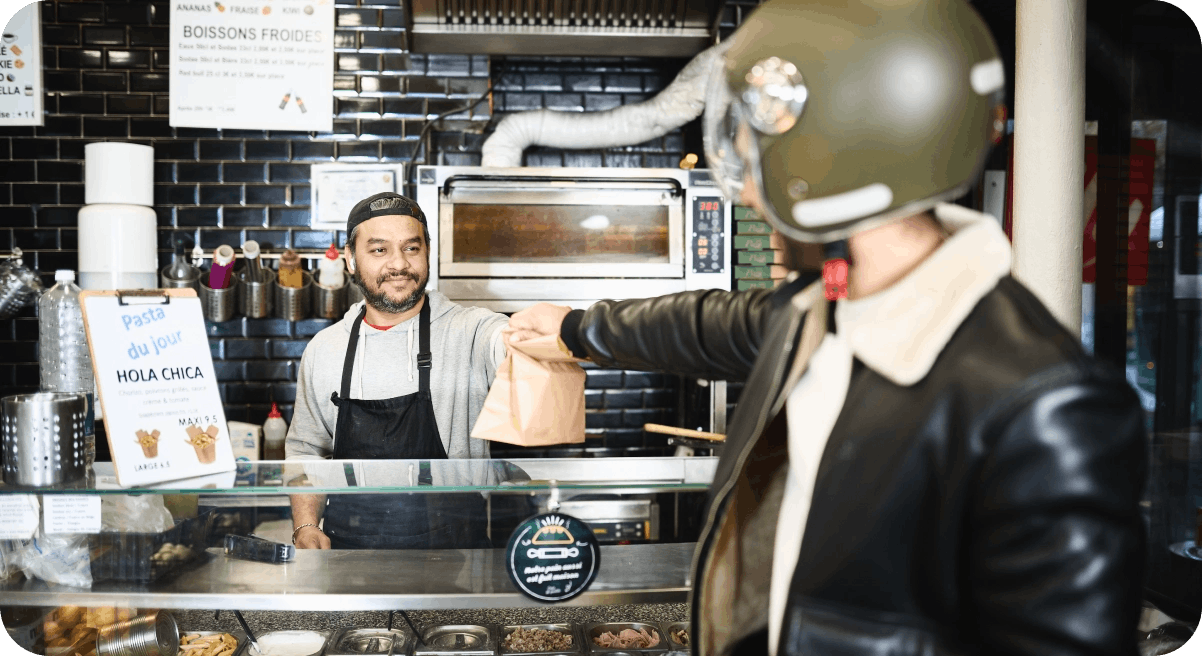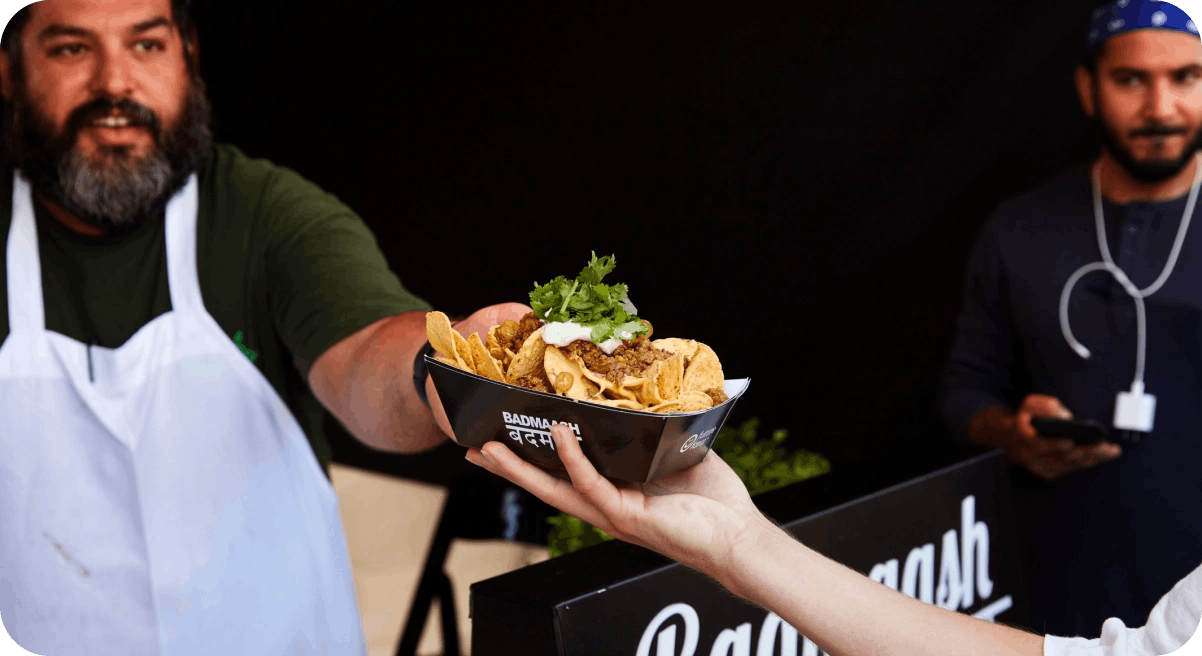
What does the hospitality industry in Australia look like in 2022?
It’s no doubt that the industry has gone through some of the biggest changes since the pre-pandemic days. But even as the past few years brought countless challenges, the restaurant industry continues to grow with a total of 10,943 businesses emerging across Australia since 2019.
NSW came in first with no surprise as the state with the highest number of restaurant venues, followed by Victoria and Queensland. Here’s a breakdown of what the restaurant industry in Australia looks like today:

Those of you who’ve been in hospitality for years would know that the industry has historically been slow to pivot and adopt changes. But things have drastically changed since. In this article, we’ll be going through some of the latest industry updates to uncover the current state of play of Australia’s hospitality industry. Keep reading to find out what’s in store!
In this blog, you’ll learn about…
- The nationwide staff shortage issue
- Top wins in hospitality and the restaurant industry
- Popular trends in Australia’s restaurant scene
- What is shaping the future of the nation’s hospitality and foodservice industry?
- Latest Federal Budget priorities: What’s in it for the hospitality industry?
Staff shortage continues to be an issue in the hospitality industry
As the industry winds down from the global pandemic crisis, restaurant operators were left with yet another problem to solve — a nationwide labour shortage. At the National Restaurant Conference held earlier last month, we learned that The Star Casino in Queensland is looking to hire as many as 8,500 employees in the next 12 months while Sydney’s heritage-listed amusement park, Luna Park, is looking for 300 staff just for cafe and restaurant staff in the last quarter of the year.
As good food and quality service (the key to every successful business) both require skilled employees, restaurant owners are finding themselves in dire straits with the current labour situation. For restaurant owners who have their fingers stuck in too many pies, staff retention is especially crucial in surviving the labour crunch. If staff retention is also something that your restaurant is laser focused on, check out our guide on quick wins to retain employees and combat the labour shortage.
Nevertheless, the industry also achieved some wins…
The past couple of years saw a shift in behaviour which changed the way consumers dine. To keep up with changing customer needs, new measures were introduced to keep businesses afloat. Here are some changes that restaurant operators in the industry have raised their glasses to:
Migration cap increase. In a quest to combat the labour shortage issue, the Australian government has raised the Permanent Migration Program ceiling from 160,000 to 195,000 in 2022-2 for the first time in decades. The government also introduced other initiatives such as extending visas and relaxing work restrictions to resolve the labour situation caused by border closures and the departure of working-holiday makers and international students.

Adding chefs to the Priority Migration Skills Occupation List. As Australia’s hospitality industry relies heavily on migrant workers to run the kitchen and front of house, the government recently added chefs as one of the 41 occupations and skills badly needed for Australia’s post-pandemic recovery in the Priority Migration Skilled Occupation List (PMSOL). To further streamline the labour market, the government also introduced the Subclass 400 visa which is a temporary visa for those who have specialised skills to assist Australian businesses.
Increased outdoor dining. To help restaurants get back to business, the government introduced the Alfresco Restart Rebate which gives small or medium food and beverage businesses a rebate of up to $5,000 to create, expand or improve their outdoor dining areas. The NSW government also permanently eased rules regarding outdoor dining to support and facilitate this initiative. Cheers to alfresco dining!
Top trends in Australia’s hospitality and restaurant scene today
Cultural Sustainability: Running a restaurant today is more than just serving good food and providing great service. Restaurant owners are making sure to create a culture of high ethical standards by adopting and practising responsible procedures from sustainable practices to taking care of your employees’ wellbeing.
Experience Economy: An experience economy in the hospitality context is how a restaurant generates profit with the quality of food and services that creates a valuable experience. This is probably not new to the hospitality industry with customer experience and satisfaction being the basics of a successful restaurant, but it’s surely what the industry is focused on post pandemic!
Holistic Hospitality: A holistic approach in the hospitality industry is all about coming up with solutions that take into consideration every aspect of your business. For example, implementing tech at different touchpoints in your restaurant to combat labour shortage issues, manage operations and create a holistic work environment for your staff.

Last Minute Mindset: One of the biggest shifts in consumer behaviour and decision making is the last-minute mindset, especially with younger consumers and their “I want it here and now” mentality. That means that as restaurateurs, it’s important to provide customers with convenience and options that are readily available for them anytime, anywhere.
Contactless Experience: From online ordering systems to contactless payment options and QR codes, it’s all about the contactless experience for restaurants today. In fact, businesses see a 35% increase in sales within the first 30 days after implementing self-serve ordering with QR codes.
Workplace Wellness: The hospitality industry is reported to have the highest rate of substance abuse and a high suicide rate. For this reason, employers are increasingly turning to healthier workplace practices through initiatives such as peer-to-peer counselling or weekly group workouts to unwind as a team.
Restaurants With A Cause: Whether it’s charity donations or showing some love to mother earth with sustainable practices, restaurants are giving back to the community. After all, the pandemic has given us cause to stick together!

Trend predictions for the Australia hospitality and foodservice industry
Even as trends come and go, there are some that are here to stay and will shape the nation’s hospitality industry in 2023 and beyond.
Adaptive Hospitality
If there’s one thing that the last few years have taught us, it’s that all businesses need to be adaptive to how the world is changing. For all of us in the hospitality industry, it’s not just about keeping up with the trends but also looking for ways to future-proof your business.
You should always be prepared to shift your business model and offerings based on the changing needs of your customers. Hubster’s innovative all-in-one product suite has all the solutions you need to optimise operations, understand your business performance and increase restaurant sales.
Tech Streamlining and Integration
One good way to future-proof your business is by automating your operation. As a matter of fact, 52% of restaurant operators believe that automation attracts patrons, while 41% say it boosts employee productivity, which is crucial as restaurants globally continue to face labour challenges.
POS integration optimises operations and reduces costs for your restaurant by consolidating your point of sale and streamlining your online orders into a single system. That way, you never have to worry about human errors and your staff can focus on serving their customers.
Investing in Workplace Culture
Not only can investing in workplace culture help retain your best employees by making sure employees feel valued, respected and well-rewarded for their hard work, it can also boost productivity around your restaurant.
Keeping up with the increase of dine-in customers and online orders with fewer staff can burn your employees out over the long haul. Fortunately, with Hubster, you can make their lives a little easier with our range of order management solutions that simplifies delivery and minimises stress for you and your employees.
Consumer Ordering Habits
Understanding your customers’ buying habits and preferences allows you to cater to their needs and improve your bottom line. Did you know that 70% of consumers prefer to order directly from restaurants instead of third party services?
Having an online ordering system like Direct Orders gives your restaurant access to a flexible and easy-to-update digital menu so customers can place their own orders for pick-up, takeaway, delivery or dine-in.
Digital Advertising Platforms
In today’s digital age, it’s never been more important for restaurants to build an online presence and there’s no easier way to do that than through running marketing campaigns on digital advertising platforms. From social media platforms to delivery app promotions, these platforms allow you to reach potential customers at home and on the go, which can help your business grow.
Not sure where to start? Promotions optimises your marketing using real data from your restaurant and competitors to automatically schedule and run promotions to boost your ranking on delivery apps. That way, you get to say goodbye to the guesswork involved in running marketing campaigns and have more time to focus on running your restaurant.
Menu Consolidation
Efficiency, flexibility and higher productivity are just a number of benefits you get when you consolidate your restaurant’s menu. But amidst the labour shortage, global supply chain issues, and overall restaurant grind, who has the time to spend hours on end updating menus?
Otter's list of menu management solutions integrates with delivery apps and web-based ordering platforms to consolidate all your online menus across locations, brands, and platforms into a single place while showing you important insights for you to make the most of your menu.

Latest Federal Budget priorities: What’s in it for the hospitality industry?
From rising inflation rates, a substantial global economic slowdown to a widespread skills shortage and falling real wages, the latest Federal Budget Priorities focuses on cost-of-living relief and building a more resilient economy in Australia.
Nailing it down for those of you in the industry, here are some of the measures that would make an impact on hospitality businesses:
- Immigration Program Expansion
- Strengthening the Australian Workforce
- Cost of Living Initiatives
- Workplace Relations Support for Small Businesses
- Tax Deduction on Business Technology & Staff Training
On top of that, CEO of the Restaurant & Catering Industry Association, Belinda Clarke also shared at the National Restaurant Conference that the association will continue to fight for better initiatives for the hospitality industry such as:
- Better Award System: Simplifying the complex awards governing restaurants, cafes and catering businesses.
- More Skilled Workers: More flexibility to current visa and immigration arrangements
- Targeted Government Spending: Ensure state and federal governments across Australia continue to invest in stimulus spending targeted to the hospitality sector.
- Added Regulation: Fighting against any new measure that would add cost or complexity to hospitality members such as stricter menu labelling, new public holidays and complicated permits and licences.
Excited for the future in hospitality? So are we. Hopefully, this article has given you a good pulse of the industry today and how you can prepare your restaurant business for the changes in the year to come!